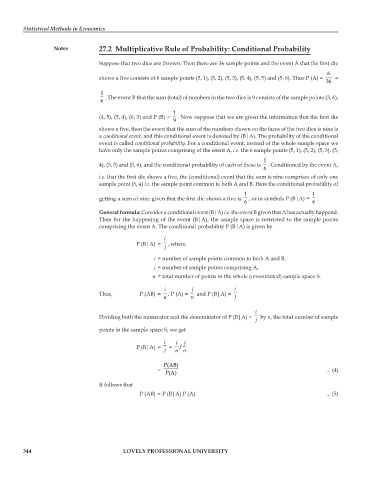Page 349 - DECO504_STATISTICAL_METHODS_IN_ECONOMICS_ENGLISH
P. 349
Statistical Methods in Economics
Notes 27.2 Multiplicative Rule of Probability: Conditional Probability
Suppose that two dice are thrown. Then there are 36 sample points and the event A that the first die
6
shows a five consists of 6 sample points (5, 1), (5, 2), (5, 3), (5, 4), (5, 5) and (5, 6). Thus P (A) = =
36
1
6 . The event B that the sum (total) of numbers in the two dice is 9 consists of the sample points (3, 6),
1
(4, 5), (5, 4), (6, 3) and P (B) = . Now suppose that we are given the information that the first die
9
shows a five, then the event that the sum of the numbers shown on the faces of the two dice is nine is
a conditional event, and this conditional event is denoted by (B|A). The probability of the conditional
event is called conditional probability. For a conditional event, instead of the whole sample space we
have only the sample points comprising of the enent A, i.e. the 6 sample points (5, 1), (5, 2), (5, 3), (5,
1
4), (5, 5) and (5, 6), and the conditional probability of each of these is . Conditioned by the event A,
6
i.e. that the first die shows a five, the (conditional) event that the sum is nine comprises of only one
sample point (5, 4) i.e. the sample point common to both A and B. Here the conditional probability of
1 1
getting a sum of nine given that the first die shows a five is , or in symbols P (B|A) = .
6 6
General formula: Consider a conditional event (B|A) i.e. the event B given that A has actually happend.
Then for the happening of the event (B|A), the sample space is restricted to the sample points
comprising the event A. The conditional probability P (B|A) is given by
i
P (B|A) = j , where
i = number of sample points common to both A and B,
j = number of sample points comprising A,
n = total number of points in the whole (unrestricted) sample space S.
i j i
Thus, P (AB) = , P (A) = and P (B|A) =
n n j
i
Dividing both the numerator and the denominator of P (B|A) = by n, the total number of sample
j
points in the sample space S, we get
i i j
/
P (B|A) = j = nn
P(AB)
= P(A) ... (4)
It follows that
P (AB) = P (B|A) P (A). ... (5)
344 LOVELY PROFESSIONAL UNIVERSITY

